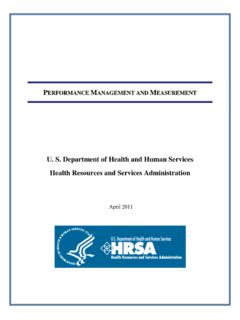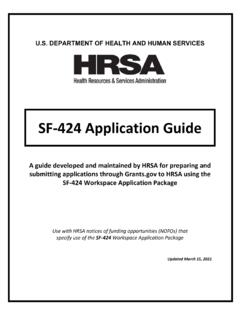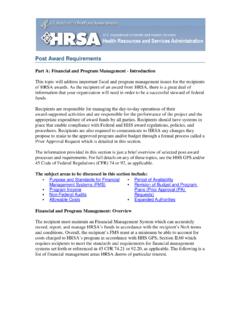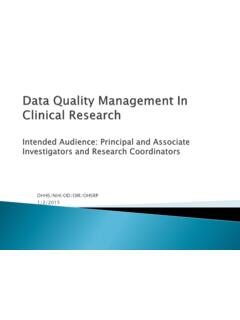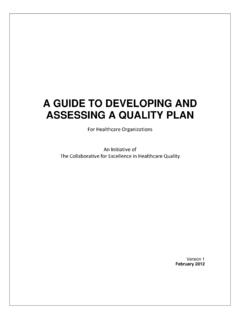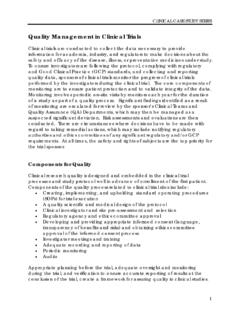Transcription of U. S. Department of Health and Human Services Health ...
1 DDEEVVEELLOOPPIINNGG AANNDD IIMMPPLLEEMMEENNTTIINNGG AA QQII PPLLAANN U. S. Department of Health and Human Services Health Resources and Services Administration April 2011 Developing and Implementing a QI Plan Contents DDEEVVEELLOOPPIINNG G AANND D IIMMPPLLEEMMEENNTTIINNG G A A QQI I PPLLAAN N .. 1 Part 1: Introduction .. 2 What Is a quality Improvement 2 QI Plan versus QI Project .. 3 Part 2: Structure and Leadership .. 3 The Organizational Structure .. 3 The Role of Leadership .. 4 Board of 4 Part 3: Developing a QI Plan .. 5 Define Organizational Priorities .. 6 Part 4: Implementing a QI Plan .. 10 Annual Evaluation and Work Plan Development .. 10 Resource Allocation .. 11 Part 6: References .. 11 1 Developing and Implementing a QI Plan DEVELOPING AND IMPLEMENTING A QI PLAN The goal of this module is to highlight the important role of an effective QI Plan in improving performance of an organization s Health care systems.
2 The module exemplifies how an organization establishes a QI plan and emphasizes elements necessary for the successful development of an organizational QI Plan. Part 1: Introduction What Is a quality Improvement Plan The QI Plan is a detailed, and overarching organizational work plan for the Health care organization's clinical and service quality improvement activities. The QI Plan is generally developed by executive and clinical leadership and in many organizations must be approved by the organizations governing body such as a Board of Directors. The QI Plan serves as a road map for all quality activities, both operational and clinical. A QI program or project would fall within the purview of the QI Plan. A QI Plan generally outlines the specific clinical focus area for the current and subsequent calendar years.
3 Often, the QI Plan is developed as an outgrowth of the evaluation of the previous year's QI activities, organizational priorities and organizational program requirements. A QI Plan should have the following characteristics: A systematic process with identified leadership, accountability, and dedicated resources; Use of data and measurable outcomes to determine progress toward relevant, evidence-based benchmarks; Focus on linkages, efficiencies, and provider and client expectations in addressing outcome improvement; Continuous process that is adaptive to change and that fits within the framework of other programmatic quality assurance and quality improvement (QI) activities ( JCAHO, Medicaid, and other HRSA programs); Data collected is used to feedback into the process to assure that goals are accomplished and they are concurrent with improved outcomes.
4 The Purpose of a QI Plan The purpose of the quality Improvement (QI) Plan is to provide a formal ongoing process by which the organization and stakeholders utilize objective measures to monitor and evaluate the quality of Services , both clinical and operational, provided to the patients. The QI Plan, which often addresses general medical, behavioral Health and oral Health care and Services , defines and facilitates a systematic approach to identify and pursue opportunities to improve Services and resolve identified problems. 2 Developing and Implementing a QI Plan QI Plan versus QI Project The QI Plan should be distinguished from a QI Project as they are very different. As mentioned in the introduction, the QI Plan is the serves as the organizations strategic plan for quality improvement.
5 The QI Plan serves as an ongoing monitoring and evaluation tool for organizations and their key stakeholders. The Plans generally outlines time-framed and realistic goals and includes related performance measures that are responsive to the identified primary Health care needs of the community served and the strategic needs of the organization. A QI Project is born out of the QI Plan. Often priority areas have been identified such as disease states prevalent in the community, or required performance measures based on funders and a QI Team will then develop a QI Project based on these priority areas. Often the QI team will review baseline data on measures outlined in the QI Plan to determine the priority of focus for the QI Project. For example if the QI Plan identifies the diabetes measure: Percentage of diabetic patients whose HbA1c levels are less than or equal to 9 percent but baseline data pulled from the Health care organization's EMR indicates that 90% of their diabetic patients have an HbA1c less than 9 percent, an organization might consider a different measure on which to focus their QI Project.
6 Possibly one that they could have a greater improvement impact. The QI Plan would still require that the organization periodically monitor the HbA1c levels for their patient population so not to drop below 90% of patients with an HbA1c less than 9% but, the QI project improvement efforts would likely be better suited to focus on a measure that the QI project could impact and focus on making significant improvements. Part 2: Structure and Leadership Organizational structure is a formal, guided process for integrating the people, information, and technology of an organization, and serves as a key structural element that allows organizations to maximize value by matching their mission and vision to their overall strategy in quality improvement. (1) Leadership and the organizational structure play a key role in the development and implementation of a QI Plan.
7 Leadership works directly and openly to improve quality by setting priorities, modeling core values, promoting a learning atmosphere, acting on recommendations, advocating for supportive policies, and allocating resources for improvement. Implementing a QI Plan requires a clear delineation of oversight roles and responsibilities and accountability. The specific organizational structure for implementing a QI Plan can vary greatly from one organization to another but one common component is the role of leadership in supporting the organizational structure. The Organizational Structure As previously stated, the organizational structure for implementing a QI Plan can vary from one organizational to another. There are however, key components to a successful organizational structure. Successful organizational structures consider characteristics such as connection to senior and board leadership.
8 Highlighted below are details on the key elements of the organizational structure in the development and implementation of a QI Plan in a Health care organization. 3 Developing and Implementing a QI Plan The Role of Leadership Planning and managing QI has become a priority for senior leaders and chief medical officers and a defining competency for successful organizations [2]. Senior leaders sit at the top of a corporation's organizational chart, and their leadership helps set the direction of the organization and guide quality -improvement planning and efforts. The link between leadership and quality has been studied in a number of organizations implementing quality improvement. These studies found an adherent link between leadership and commitment to a quality -improvement processes.
9 (3) They found that top management s physical presence, visibility and concern for quality improvement were associated with transformational leadership and demonstrated that leadership directly impacts the commitment of an organization to quality improvement. Board of Directors Momentum has built over time for Health care organization boards to be involved in and accountable for the quality of care delivered at their institutions [4]. The 1999 report, To Err is Human , describes patient safety as a necessary organizational goal. It further states, this process begins when boards of directors demonstrate their commitment to this objective by regular, close oversight of the safety of the institutions they shepherd. Delivering high- quality care is becoming increasingly recognized as the responsibility of the entire organization.
10 As payment structures evolve and incentive plans in consideration of payment for quality evolve, it is important that an organization work to involve the board in the development and management of the organizations QI Plan. The chart below highlights tools to help support and engage boards in the organizations development and management of the organizations QI Plan. Many of these tools address overcoming common barriers to boards such as poor communication between boards and physicians, fragmented information exchange, inadequate investment and disjointed committee structures. Tools/Resources to engage the Board of Directors in QI Plan Development Name Link Healthy People 2020 Community Guide National Association of Community Health Centers Crossing the quality Chasm: A New Health System for the 21st Century Performance Management & Building QI into the organizations Culture (Mason) 4 Developing and Implementing a QI Plan Information Management (Technology) Information management and technology are critical to improving quality .

